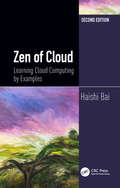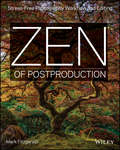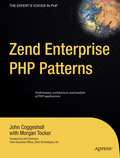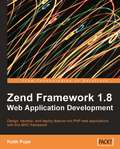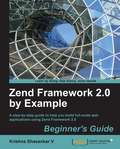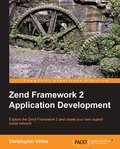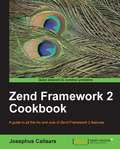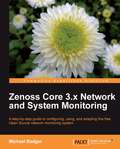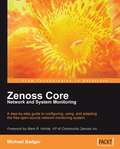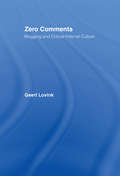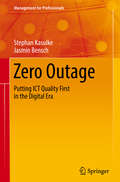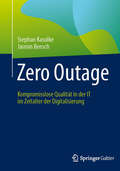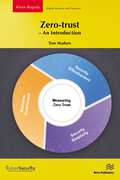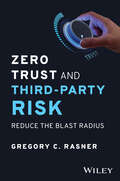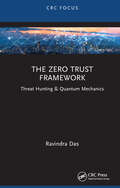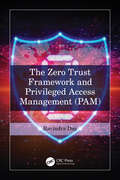- Table View
- List View
Zen and the Art of Information Security
by Ira WinklerWhile security is generally perceived to be a complicated and expensive process, Zen and the Art of Information Security makes security understandable to the average person in a completely non-technical, concise, and entertaining format. Through the use of analogies and just plain common sense, readers see through the hype and become comfortable taking very simple actions to secure themselves. Even highly technical people have misperceptions about security concerns and will also benefit from Ira Winkler's experiences making security understandable to the business world. Mr. Winkler is one of the most popular and highly rated speakers in the field of security, and lectures to tens of thousands of people a year. Zen and the Art of Information Security is based on one of his most well received international presentations. - Written by an internationally renowned author of Spies Among Us who travels the world making security presentations to tens of thousands of people a year - This short and concise book is specifically for the business, consumer, and technical user short on time but looking for the latest information along with reader friendly analogies - Describes the REAL security threats that you have to worry about, and more importantly, what to do about them
Zen of Cloud: Learning Cloud Computing by Examples, Second Edition
by Haishi BaiThis book provides a comprehensive review of cloud philosophy, design principals, development trends as well as practical patterns to guide readers to understand, design and implement successful cloud-based solutions. This book provides both "hows" and "whys." It peers behind the buzz words such as machine learning, containers, and blockchains to help readers understand how to put those technologies into practical use. This unique book covers a broad spectrum of technologies of cloud computing.
Zen of Cloud: Learning Cloud Computing by Examples, Second Edition
by Haishi BaiThis book provides a comprehensive review of cloud philosophy, design principals, development trends as well as practical patterns to guide readers to understand, design and implement successful cloud-based solutions. This book provides both "hows" and "whys." It peers behind the buzz words such as machine learning, containers, and blockchains to help readers understand how to put those technologies into practical use. This unique book covers a broad spectrum of technologies of cloud computing.
Zen of Postproduction: Stress-Free Photography Workflow and Editing
by Mark FitzgeraldBreathe deep and relax - this book takes the stress out of photography post-production While capturing the perfect photograph is a welcome creative challenge for photographers, post-production can often be a headache. Downloading, sorting, tagging, editing, and distributing your digital images - especially the enormous quantities produced in today's image-happy world - can be overwhelming. Time to take a deep breath and sit down with a copy of this calming book. Digital worksflow teacher and author Mark Fitzgerald offers low-stress, post-production photography workflows and editing solutions that will make your life easier. Walking you through the latest photography software, especially Adobe Lightroom and Adobe Photoshop, Mark offers sensible advice and answers all your post-production questions, whether you're a professional photographer, serious amateur, or motivated novice. Takes the stress out of photography post-production by offering effective, timesaving, no-hassle solutions for overworked digital photographers Helps you streamline and simplify such post-production tasks as downloading, sorting, tagging, editing, and distributing digital images Explores the latest photography software, with special emphasis on Adobe Lightroom and Adobe Photoshop Offers straightforward advice for professional photographers and serious amateurs Includes practical, real-world examples, so you can immediately apply what you're learning Get into a better, more relaxing place with your photography post-production workflows and tasks with Zen of Post Production: Stress-Free Photography Workflow and Editing.
Zend Enterprise PHP Patterns
by John Coggeshall Morgan TockerZend Enterprise PHP Patterns is the culmination of years of experience in the development of web-based applications designed to help enterprises big and small overcome the challenges of the web-based application world and achieve harmony in not only the architecture of their application, but also the entire process under which that application is created and maintained. Taken directly from real-life experiences in PHP application development, Zend Enterprise PHP Patterns will help you Utilize open source technologies such as PHP and Zend Framework to build robust and easy-to-maintain development infrastructures. Understand Zend Framework and its philosophical approach to building complex yet easy-to-maintain libraries of functionality for your application that can scale with your needs. Benefit through an in-depth discussion of tools and techniques that can significantly enhance your ability to develop code faster, fix bugs, and increase performance.
Zend Framework 1.8 Web Application Development: Design, Develop, And Deploy Feature-rich Php Web Applications With This Mvc Framework
by Keith PopeThis book is an example-driven tutorial that takes you through the process of building Model-View-Controller-based web applications. You will create and develop a storefront application. It also covers common mistakes and best practices that will be helpful for developers. This book is for PHP web developers who want to get started with Zend Framework. If you are already using this framework, you will learn how to use it in the best way and produce better applications. Basic knowledge of Object Oriented design will be helpful.
Zend Framework 2.0 by Example: Beginner's Guide
by Krishna Shasankar VZend Framework 2.0 by Example: Beginner's Guide is a step-by-step guide that aims to empower you to build web applications packed with some really exciting features using Zend Framework 2.0.If you are a PHP Developer who is new to Zend Framework, but you want to get hands-on with the product quickly, this book is for you. Basic knowledge of object oriented programming with PHP is expected.
Zend Framework 2 Application Development
by Christopher VallesThe book is really pragmatic, focusing on the key aspects you usually need to create an application. We skip the boring theory and jump straight to the action. Also, the examples don't try to be perfect, they just show the topic in question or the tool/components we are using. Here the focus is on the framework itself not on how to architect applications. The book will spend a lot of time reviewing the examples and each chapter is created around the example used to explain the topics so the example is first, then the explanation.This book is great for you if you are new to Zend Framework 2 and are looking to get a practical approach in how to use the framework. This book will be also really helpful if you are a Zend Framework 1 user but you want to adapt you knowledge to the new version of the framework. It's assumed that you will have good experience using PHP and specially with the Object Oriented programming paradigm.
Zend Framework 2 Cookbook
by Josephus CallaarsThis book is written in a practical, cookbook style with numerous examples and recipes. This style allows you to go both directly to your topic of interest or follow topics throughout a chapter to gain an in-depth knowledge of certain areas.'Zend Framework 2 Cookbook" is for PHP developers who are fairly advanced in programming in PHP. It will also be useful for developers who have a keen interest in expanding their knowledge outside the boundaries of simply scripting pages together. As unit testing and MVC will be discussed, it is beneficial for the reader to know what these technologies are, although experience with developing applications is not necessarily essential.
Zenoss Core 3.x Network and System Monitoring
by Michael BadgerThe book starts by covering installation and configuration, before moving on to administration and dashboard usage. It contains step-by-step instructions for setting up and using a working, capable Zenoss system. This book is written primarily for network and systems administrators who are monitoring their IT assets with Zenoss Core or who plan to monitor them. In reality, this book will benefit anyone, regardless of job title, who recognizes the importance of proactively monitoring the servers, routers, computers, websites, and devices that connect companies to customers.
Zenoss Core Network and System Monitoring: Michael Badger
by Michael BadgerThe book starts by covering installation and configuration, before moving onto administration and dashboard usage.The book contains step-by-step instructions for setting up and using a working, capable Zenoss system. From small business to a large enterprise, this books helps organizations collect data, monitor, and report on their IT assets. Zenoss Core offers a feature-rich, accessible solution to organizations that lack the financial resources to purchase a proprietary monitoring solution or the technical resources. This book makes no distinction about your existing systems management knowledge or lack; thereof and assumes everyone is new to Zenoss Core. The emphasis is on configuring and administering a monitoring environment from the comforts of a graphical web interface.
Zephyr RTOS Embedded C Programming: Using Embedded RTOS POSIX API
by Andrew EliaszThese days the term Real-Time Operating System (RTOS) is used when referring to an operating system designed for use in embedded microprocessors or controllers. The “Real Time” part refers to the ability to implement applications that can rapidly responding to external events in a deterministic and predictable manner. RTOS-based applications have to meet strict deadline constraints while meeting the requirements of the application. One way of ensuring that urgent operations are handled reliably is to set task priorities on each task and to assign higher priorities to those tasks that need to respond in a more timely manner.Another feature of real-time applications is the careful design and implementation of the communication and synchronization between the various tasks. The Zephyr RTOS was developed by Wind River Systems, and subsequently open sourced. Its design and implementation are oriented towards the development of time critical IoT (Internet of Things) and IIoT (Industrial Internet of Things) applications, and, consequently it has a rich feature set for building both wireless and wired networking applications. However, with a rich feature set comes a fairly steep learning curve.This book covers the foundations of programming embedded systems applications using Zephyr's Kernel services. After introducing the Zephyr architecture as well as the Zephyr build and configuration processes, the book will focus on multi-tasking and inter-process communication using the Zephyr Kernel Services API. By analogy with embedded Linux programming books, this book will be akin a Linux course that focuses on application development using the Posix API. In this case, however, it will be the Zephyr Kernel Services API that will be the API being used as well as the Posix API features supported by Zephyr.What You’ll learnAn Overview of the Cortex-M Architecture.Advanced data structures and algorithms programming (linked lists, circular buffers and lists).How to build Zephyr Applications, including setting up a Command Line Zephyr Development Environment on Linux.Task scheduling and pre-emption patterns used in Real Time Operating Systems.Scheduling, Interrupts and Synchronization, including threads, scheduling, and system threads.Overview of Symmetric Multiprocessing (SMP) and Zephyr support for SMP. Memory management, including memory heaps, memory slabs, and memory pools.Who This Book Is ForEmbedded Systems programmers, IoT and IIoT developers, researchers, BLE application developers (Industrial Control Systems, Smart Sensors, Medical Devices, Smart Watches, Manufacturing, Robotics). Also of use to undergraduate and masters in computer science and digital electronics courses.
Zero Comments: Blogging and Critical Internet Culture (Kultur- Und Medientheorie Ser.)
by Geert LovinkIn Zero Comments, internationally renowned media theorist and 'net critic' Geert Lovink revitalizes worn out concepts about the Internet and interrogates the latest hype surrounding blogs and social network sites. In this third volume of his studies into critical Internet culture, following the influential Dark Fiber and My First Recession, Lovink develops a 'general theory of blogging.' He unpacks the ways that blogs exhibit a 'nihilist impulse' to empty out established meaning structures. Blogs, Lovink argues, are bringing about the decay of traditional broadcast media, and they are driven by an in-crowd dynamic in which social ranking is a primary concern. The lowest rung of the new Internet hierarchy are those blogs and sites that receive no user feedback or 'zero comments'. Zero Comments also explores other important changes to Internet culture, as well, including the silent globalization of the Net in which the West is no longer the main influence behind new media culture, as countries like India, China and Brazil expand their influence and looks forward to speculate on the Net impact of organized networks, free cooperation and distributed aesthetics.
Zero Comments: Blogging and Critical Internet Culture
by Geert LovinkIn Zero Comments, internationally renowned media theorist and 'net critic' Geert Lovink revitalizes worn out concepts about the Internet and interrogates the latest hype surrounding blogs and social network sites. In this third volume of his studies into critical Internet culture, following the influential Dark Fiber and My First Recession, Lovink develops a 'general theory of blogging.' He unpacks the ways that blogs exhibit a 'nihilist impulse' to empty out established meaning structures. Blogs, Lovink argues, are bringing about the decay of traditional broadcast media, and they are driven by an in-crowd dynamic in which social ranking is a primary concern. The lowest rung of the new Internet hierarchy are those blogs and sites that receive no user feedback or 'zero comments'. Zero Comments also explores other important changes to Internet culture, as well, including the silent globalization of the Net in which the West is no longer the main influence behind new media culture, as countries like India, China and Brazil expand their influence and looks forward to speculate on the Net impact of organized networks, free cooperation and distributed aesthetics.
Zero-Day Exploit: Countdown to Darkness (Cyber-Fiction)
by Rob SheinThe realistic portrayals of researching, developing, and ultimately defending the Internet from a malicious "Zero-Day" attack will appeal to every corner of the IT community. Although finctional, the numerous accounts of real events and references to real people will ring true with every member of the security community. This book will also satisfy those not on the "inside" of this community, who are fascinated by the real tactics and motives of criminal, malicous hackers and those who defent the Internet from them.* The realistic portrayals of researching, developing, and ultimately defending the Internet from a malicious "Zero-Day" attack will appeal to every corner of the IT community.* This book will entertain, educate, and enlighten the security and IT community about the world of elite security professionals who safeguard the Internet from the most dangerous cyber criminals and terrorists.* Although finctional, the numerous accounts of real events and references to real people will ring true with every member of the security community.
Zero Outage: Putting ICT Quality First in the Digital Era (Management for Professionals)
by Stephan Kasulke Jasmin Bensch Ferri AbolhassanThis reference book shows how the Zero Outage method leads to more stability in operations, more reliability in projects and, ultimately, to greater customer satisfaction. It explains why clear standards for platforms, processes and personnel are essential for ensuring high ICT quality from end to end and what to look out for during changes – the most common cause of IT outages. Readers also learn how to resolve errors as quickly as possible and permanently eliminate them, and why industry-wide collaboration will only be possible with a shared standard of quality. This book is a practical introduction to making your ICT world even more failsafe and efficient. The authors share key knowledge in quality management and offer an exclusive insight into their extensively tested and continually enhanced formula for success: the Zero Outage approach.
Zero Outage: Kompromisslose Qualität in der IT im Zeitalter der Digitalisierung
by Stephan Kasulke Jasmin Bensch Ferri AbolhassanDas Fachbuch zeigt, wie die Zero-Outage-Methode zu mehr Stabilität im Betrieb, mehr Zuverlässigkeit in Projekten und letztlich zu einer größeren Kundenzufriedenheit führt. Es verdeutlicht, weshalb klare Standards bei Plattformen, Prozessen und Personal unverzichtbar sind, um eine hohe ICT-Qualität von Ende zu Ende sicherzustellen und worauf es bei Changes – den häufigsten Ursachen für IT-Ausfälle – ankommt. Zudem erfahren die Leser, wie man Störungen schnellstmöglich behebt und dauerhaft abstellt und warum die Zusammenarbeit von ICT-Anbietern künftig nur mit einem gemeinsamen Qualitätsstandard gelingen kann. So dient dieses Buch als praxisnahe Anleitung, die eigene ICT-Welt noch ausfallsicherer und leistungsfähiger zu machen. Dazu teilen die Autoren ihre wichtigsten Erkenntnisse im Qualitätsmanagement und geben einen exklusiven Einblick in ihr – über viele Jahre erprobtes und kontinuierlich weiterentwickeltes – Erfolgsrezept: den Zero-Outage-Ansatz.
Zero to Hero in Cryptocurrency Trading: Learn to trade on a centralized exchange, understand trading psychology, and implement a trading algorithm
by Bogdan VaidaGo from the bare basics to implementing your own automatic trading algorithm and become a cryptocurrency trading proKey FeaturesExcel at crypto trading with structured methodologies, practical examples, and real-time trading scenariosGo from the theoretical know-how to developing and testing your own strategyTransform manual trades into an automated algorithm for nonstop tradesPurchase of the print or Kindle book includes a free PDF eBookBook DescriptionIn today's fast-paced digital age, cryptocurrencies have emerged as a revolutionary financial asset class, capturing the attention of investors and traders worldwide. However, navigating the world of cryptocurrency trading can be overwhelming for beginners. Zero to Hero in Cryptocurrency Trading acts as a guiding light to navigate this complex realm. This comprehensive guide to cryptocurrency trading empowers you to go from a novice trader to a proficient investor by helping you implement your own trading strategy. As you progress, you’ll gain structured trading knowledge through hands-on examples and real-time scenarios, bolstered by trading psychology and money management techniques. You’ll be able to automate your manual trades with an algorithm that works even while you sleep. You’ll also benefit from interactive teaching methods, including screenshots, charts, and drawings to help decode market operations and craft your unique edge in the dynamic crypto world. As an added bonus, you’ll receive ready-to-use templates to identify useful indicators, test your strategy, and even maintain a trading journal. By the end of this book, you’ll be well-equipped to trade cryptocurrencies and automate manual trading to give you an edge in the markets.What you will learnMaster trading psychology and prevent emotions from sabotaging tradesManage risks by identifying and tailoring specific risk profilesInterpret, assess, and integrate technical indicators in your tradingGet to grips with trading on a centralized exchangeGet a deeper understanding of risk and money managementGain an edge by identifying trading patternsAutomate the patterns into a strategy for a bot that operates 24/7Who this book is forThis book is for finance and investment professionals, crypto market enthusiasts, and anyone new to trading who wants to kickstart their cryptocurrency trading journey. A basic understanding of cryptocurrencies is a must, but prior trading experience is not necessary.
Zero-trust – An Introduction (River Publishers Rapids Series in Digital Security and Forensics)
by Tom MadsenThe book provides you with information on how to implement and manage a zero-trust architecture across these different layers of an infrastructure. It is an introduction to the overall purpose of zero-trust and the benefits that zero-trust can bring to an infrastructure, across many different technologies: Cloud Networking Identity management Operational Technology (OT) 5G Zero-trust is not a product, but a way of thinking about design and architecture. Cisco and Microsoft are used as the technology vendors, but the steps and information are equally applicable to other technology vendors.
Zero-trust – An Introduction (River Publishers Rapids Series in Digital Security and Forensics)
by Tom MadsenThe book provides you with information on how to implement and manage a zero-trust architecture across these different layers of an infrastructure. It is an introduction to the overall purpose of zero-trust and the benefits that zero-trust can bring to an infrastructure, across many different technologies: Cloud Networking Identity management Operational Technology (OT) 5G Zero-trust is not a product, but a way of thinking about design and architecture. Cisco and Microsoft are used as the technology vendors, but the steps and information are equally applicable to other technology vendors.
Zero Trust and Third-Party Risk: Reduce the Blast Radius
by Gregory C. RasnerDramatically lower the cyber risk posed by third-party software and vendors in your organization In Zero Trust and Third-Party Risk, veteran cybersecurity leader Gregory Rasner delivers an accessible and authoritative walkthrough of the fundamentals and finer points of the zero trust philosophy and its application to the mitigation of third-party cyber risk. In this book, you’ll explore how to build a zero trust program and nurture it to maturity. You will also learn how and why zero trust is so effective in reducing third-party cybersecurity risk. The author uses the story of a fictional organization—KC Enterprises—to illustrate the real-world application of zero trust principles. He takes you through a full zero trust implementation cycle, from initial breach to cybersecurity program maintenance and upkeep. You’ll also find: Explanations of the processes, controls, and programs that make up the zero trust doctrine Descriptions of the five pillars of implementing zero trust with third-party vendors Numerous examples, use-cases, and stories that highlight the real-world utility of zero trustAn essential resource for board members, executives, managers, and other business leaders, Zero Trust and Third-Party Risk will also earn a place on the bookshelves of technical and cybersecurity practitioners, as well as compliance professionals seeking effective strategies to dramatically lower cyber risk.
Zero Trust and Third-Party Risk: Reduce the Blast Radius
by Gregory C. RasnerDramatically lower the cyber risk posed by third-party software and vendors in your organization In Zero Trust and Third-Party Risk, veteran cybersecurity leader Gregory Rasner delivers an accessible and authoritative walkthrough of the fundamentals and finer points of the zero trust philosophy and its application to the mitigation of third-party cyber risk. In this book, you’ll explore how to build a zero trust program and nurture it to maturity. You will also learn how and why zero trust is so effective in reducing third-party cybersecurity risk. The author uses the story of a fictional organization—KC Enterprises—to illustrate the real-world application of zero trust principles. He takes you through a full zero trust implementation cycle, from initial breach to cybersecurity program maintenance and upkeep. You’ll also find: Explanations of the processes, controls, and programs that make up the zero trust doctrine Descriptions of the five pillars of implementing zero trust with third-party vendors Numerous examples, use-cases, and stories that highlight the real-world utility of zero trustAn essential resource for board members, executives, managers, and other business leaders, Zero Trust and Third-Party Risk will also earn a place on the bookshelves of technical and cybersecurity practitioners, as well as compliance professionals seeking effective strategies to dramatically lower cyber risk.
The Zero Trust Framework: Threat Hunting & Quantum Mechanics
by Ravindra DasThe Cybersecurity landscape is a daunting one today. It is nothing like it was 10 years ago. Now, it has become very complex, covert, dynamic, and stealthy. It has literally become a cat and mouse game, in which the Cyberattacker is still one step ahead. This is despite all of the technology that is available to us a society, which includes Artificial Intelligence (AI) and Machine Learning. Part of the other problem is that human beings are resistant to change. For example, the password is still the favored way of authenticating and authorizing an individual, but it too has shown its grave limitations. Despite the use of Password Managers, which can create long and complex passwords, people still resort to their old fashioned ways of doing things. So what is needed now is an extreme change, in which, unfortunately, people have no choice in whether or not they will participate. It is called the Zero Trust Framework, and in this methodology, absolutely nobody can be trusted in either the internal or the external environments. The mantra here is to keep verifying everybody, all the time. The Zero Trust Framework also involves the concept of segmentation, in which the IT and Network Infrastructure of a business is broken down into smaller components, much like a Subnet. Each component will have its own layer of security, and every individual must be authenticated via the use of Multifactor Authentication (MFA). In this book, we review both the concepts and mechanics behind the Zero Trust Framework. We also introduce advanced technologies into it, including the use of Biometrics, the Public Key Infrastructure, and Quantum Mechanics/Quantum Cryptography.
The Zero Trust Framework: Threat Hunting & Quantum Mechanics
by Ravindra DasThe Cybersecurity landscape is a daunting one today. It is nothing like it was 10 years ago. Now, it has become very complex, covert, dynamic, and stealthy. It has literally become a cat and mouse game, in which the Cyberattacker is still one step ahead. This is despite all of the technology that is available to us a society, which includes Artificial Intelligence (AI) and Machine Learning. Part of the other problem is that human beings are resistant to change. For example, the password is still the favored way of authenticating and authorizing an individual, but it too has shown its grave limitations. Despite the use of Password Managers, which can create long and complex passwords, people still resort to their old fashioned ways of doing things. So what is needed now is an extreme change, in which, unfortunately, people have no choice in whether or not they will participate. It is called the Zero Trust Framework, and in this methodology, absolutely nobody can be trusted in either the internal or the external environments. The mantra here is to keep verifying everybody, all the time. The Zero Trust Framework also involves the concept of segmentation, in which the IT and Network Infrastructure of a business is broken down into smaller components, much like a Subnet. Each component will have its own layer of security, and every individual must be authenticated via the use of Multifactor Authentication (MFA). In this book, we review both the concepts and mechanics behind the Zero Trust Framework. We also introduce advanced technologies into it, including the use of Biometrics, the Public Key Infrastructure, and Quantum Mechanics/Quantum Cryptography.
The Zero Trust Framework and Privileged Access Management (PAM)
by Ravindra DasThis book is about the Zero Trust Framework. Essentially, this is a methodology where the IT/Network Infrastructure of a business is segmented into smaller islands, each having its own lines of defense. This is primarily achieved through the use of Multifactor Authentication (MFA), where at least three more authentication layers are used, preferably being different from one another.Another key aspect of the Zero Trust Framework is known as Privileged Access Management (PAM). This is an area of Cybersecurity where the protection of superuser accounts, rights, and privileges must be protected at all costs from Cyberattackers. In this regard, this is where the Zero Trust Framework and PAM intertwine, especially in a Cloud-based platform, such as Microsoft Azure.However, as it has been reviewed in one of our previous books, the use of passwords is now becoming a nemesis, not only for individuals but for businesses as well. It is hoped that by combining the Zero Trust Framework with PAM, password use can be eradicated altogether, thus giving rise to a passwordless society.

